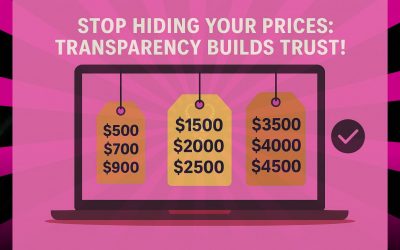Price Transparency Is the Trust Builder Your Business Needs
If you’re still treating your prices like classified information, you’re leaving money, trust, and momentum on the table.
In 2025, customers expect answers. They expect transparency. And they definitely expect to know what they’re getting into before they book.
This isn’t about publishing a full price book on your homepage. It’s about making transparency a core part of how you market and sell — especially if you’re in the home services industry.
Let’s get into why.
People Don’t Trust What They Can’t See
“Imagine walking into a restaurant with no menu. No prices listed. Just a waiter who says, ‘Don’t worry, we’ll take care of you.’ You’d probably walk right out, right?”
That’s exactly how your customers feel when they visit your site and can’t find a single clue about pricing. It doesn’t make them curious. It makes them skeptical.
They’re asking:
- Is this company hiding something?
- Am I about to get ripped off?
- Why do I have to call to get a simple number?
If you want to build trust fast, be upfront. Show that you’re confident in your pricing, your value, and your process.
Transparency Doesn’t Mean Giving It All Away
You don’t need to list every single service down to the last penny. But you can create clarity with:
- Starting at pricing
- Tiered packages (good, better, best)
- Common service examples
- Price ranges with context
“Most drain cleanings run between 200 and 400, depending on the severity and access.”
That one line does more to earn trust than a whole homepage of fluff about being family-owned and dedicated to excellence.
Price Hiding Hurts Your Sales Process
When your sales team has to start every call by justifying the price instead of explaining the value, that’s a broken funnel.
You’re setting them up to defend instead of guide.
And worse, you’re burning time on unqualified leads who were never going to buy in the first place.
Price transparency isn’t just good for your customers. It’s good for your team.
It:
- Filters out tire kickers
- Speeds up conversions
- Shifts the conversation to value instead of cost
Your Competitors Are Already Doing It
Scroll through enough Google results and you’ll see it. The top-performing home service companies are giving real pricing context:
- “Water heater installs starting at 1495”
- “99 tune-up special through April 30”
- “Membership plans from 18 per month”
This isn’t just marketing. It’s positioning.
“When customers compare your blank website to someone else’s that’s clear, detailed, and upfront, you lose the sale before you even get the call.”
The Psychology of Anchoring
There’s a concept in behavioral economics called anchoring. It means the first number someone sees shapes what they expect to pay.
If the first plumbing website they see says most toilet replacements start at 650, that becomes the benchmark.
Even if they don’t remember the exact number, they use it to evaluate your quote. If you’ve hidden your prices and suddenly drop a 1200 estimate on them, it feels off.
“Transparent pricing lets you set the anchor yourself. Don’t let someone else own the narrative.”
Transparency Can Be Your Differentiator
Price transparency is still rare in the trades. Especially for mid-sized and growing companies.
That means it’s a massive opportunity.
If your competitors are still hiding behind “call for pricing,” you can stand out fast by doing the opposite.
It’s one of the simplest ways to:
- Build trust
- Show confidence
- Reduce friction
- Speed up your sales cycle
Even better? It aligns with how people buy everything else — from pizza to cars to legal services. They want a sense of price before they commit.
Worried You’ll Scare People Away?
Good. That’s the point.
You don’t want every lead. You want the right leads.
“If someone’s max budget is 150 and your lowest service is 450, they were never your customer.”
Being vague to get more calls is short-term thinking. It creates more work, more frustration, and more friction.
Being transparent upfront filters your audience so your phone only rings with people who are already a better fit.
Practical Ways to Add Price Transparency Today
Here’s how to do it without overcomplicating your site:
- Add a pricing page with simple descriptions and ranges
- Use tiered options — good, better, best — to guide expectations
- Include pricing examples in service pages or FAQs
- Talk about price in your blog posts to add more context
- Use video to explain your pricing logic and what’s included
- Create downloadable guides or PDFs with your top services and average costs
And most importantly, don’t hide the page. Make it part of your main nav or homepage.
A Real-World Example
At The Greatful Plumber, we started showing ballpark prices for common services: toilet installs, tankless water heaters, main line replacements. Just enough info to give people a starting point.
Almost immediately, the quality of leads improved:
- Fewer “just checking” calls
- More pre-sold customers
- Shorter time from quote to close
“We even started closing higher-ticket jobs faster because the customer already had the context and wasn’t shocked by the numbers.”
Addressing the Gray Areas
Some people worry that price transparency is too risky because jobs vary so much. That’s valid, but it’s not a reason to stay silent.
You can add disclaimers like:
- “Every home is different, but this gives you a general idea.”
- “Final pricing depends on access, materials, and job complexity.”
That’s enough to cover your bases without making your site feel like a mystery novel.
Internal Buy-In Matters
None of this works if your own team isn’t on board.
Make sure your techs, CSRs, and sales reps understand the why behind the numbers. Train them to talk through value, not just cost.
“Your pricing is only as good as the people explaining it.”
Invest in scripts, cheat sheets, and role play so everyone’s aligned.
You Can’t Optimize What You’re Hiding
From a digital strategy standpoint, transparency is trackable.
When people visit a pricing page, you learn what matters to them:
- Which services get clicked?
- Where do they bounce?
- Do they book more after seeing prices?
You get none of that data if the information isn’t on your site. And without data, your digital marketing is just guesswork.
“Make your site a tool, not a brochure.”
Final Word
If you’re serious about growth, stop hiding your prices. Start showing your value.
Price transparency isn’t about low prices. It’s about clear value.
It helps customers trust you faster. It helps your team sell with confidence. And it helps your business stand out in a crowded, skeptical market.
So be the company that sets the tone, not the one that waits to react.




